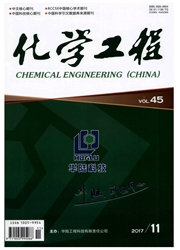

 中文摘要:
中文摘要:
采用等体积质量分数30%的H2 O2溶液和离子液体[ BMIm] Cl的混合液对提取自造纸黑液的碱木质素氧化改性后,清液加水再生,所得氧化改性碱木质素结构上发生解聚和活化,热稳定性显著降低。 FT-IR分析表明,改性后碱木质素发生了部分解聚并仍保留着木质素的主要官能团结构,且邻位二取代酚类结构含量增多;XRD分析表明,改性后杂质盐被脱除,晶体衍射强度减弱,碱木质素解聚使有机结构复杂性增强,其紫丁香基结构经氧化降解产物类似2,6-二羟基苯甲酸结构;由SEM分析可知,碱木质素团聚结构由氧化改性前的杂乱紧簇晶体状转变为改性后较为规则的层状叠加结构,颗粒粒径则大幅减小。而TG/DTG/DTA分析发现氧化改性后的碱木质素热分解温区收窄为533—649 K,最大分解速率加快1倍,969 K时总质量损失率上升约15%。研究表明,经离子液体[ BMIm] Cl中H2 O2氧化改性后的碱木质素,降低了其在材料合成和热解制备化学品的工艺操作条件,可进一步拓展其在化工产品中的应用。
 英文摘要:
英文摘要:
A mixed solution with isopyknic hydrogen peroxide 30%( mass fraction ) aqueous solution and an ionic liquid [ BMIm] Cl was used to oxygenize kraft lignin from black liquor .The treated kraft lignin was regenerated from the mixed solution and labeled as Oxidizing Modified Kraft Lignin ( OMKL ) .The structure of OMKL was depolymerized and activated,which was characterized via Fourier transform infrared spectroscopy (FT-IR), X-ray diffraction (XRD) and scanning electron microscope (SEM).Its thermo stability was reduced by TG/DTG/DTA. FT-IR analysis shows that partial depolymerizing occurs in OMKL , and the primary functional groups of lignin are still retained , but the content of para-disubstitution phenols is increased .XRD analysis infers that OMKL is isolated with impure salts, and the diffraction intensity is weaken ,which means the kraft lignin depolymerizing makes the organic structures become more complex than before .A crystal structure which is similar to 2,6-dihydroxy-benzoic acid is found as the product from sinapyl group oxidizing depolymerized .SEM photos show that a disorder cluster crystal as kraft lignin is transformed into a regular layer plate as OMKL , and the diameter of particles also becomes decreased .TG/DTG/DTA data indicate that the temperature range of OMKL pyrolysis is narrowed between 533 K and 649 K, the maximum decomposing velocity is accelerated double , and the total mass loss rate is grown by about 15%at 969 K.All studies demonstrate that using kraft lignin modified by H 2 O2 in ionic liquid [ BMIm] Cl as raw material can reduce the operational conditions in the fields of new material synthetizing and pyrolysis for value -added chemicals , thus expanding the lignin applications in chemical products .
 同期刊论文项目
同期刊论文项目
 同项目期刊论文
同项目期刊论文
 期刊信息
期刊信息
